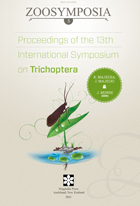Abstract
Apatania volscorum Moretti, Cianficconi & Papagno has been found only in the Italian region of Lazio. It is endemic to a rheocrenic spring in Lake Posta Fibreno (Frosinone, Italy). In this study we examined the silk glands as well as the case organization and silk lining in both the larva and the pupa by means of light and scanning electron microscope. The silk glands are long, folded 4 times and occupy most of the body cavity. The case of the 5th instar larva is 7 mm long, conical, slightly curved and made of irregularly arranged pebbles of different sizes. The anterior opening is oblique and surrounded by larger pebbles. The posterior end is rounded and closed by a membrane with an irregular hole. The silk lining is made of layers of intersecting threads 4µm thick. The pupal case, about 10 mm long, has a wide anterior opening covered by an extended silk plug and partially attached to a large, flat pebble. The posterior silk plugging is a dense membrane with 3 small holes. Examination of the silk organization in this species showed that the case lining is made of densely woven threads arranged in superimposed layers.

